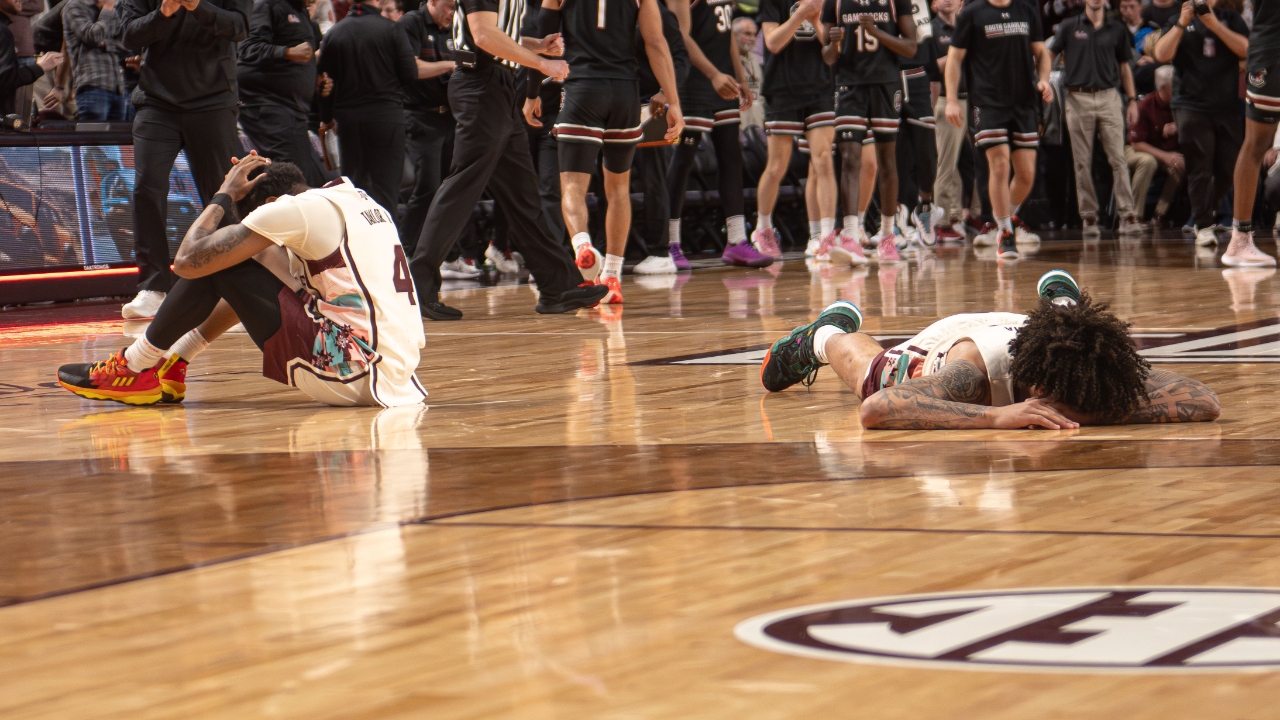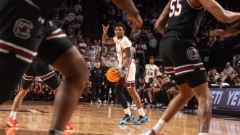
Final-play flop vs. Gamecocks hands Texas A&M fifth-straight loss
As if a five-game losing streak isn’t discouraging enough, the Aggies got a double dose of frustration on Wednesday night.
A final play that might have given Texas A&M a final shot to escape a 70-68 Southeastern Conference basketball loss to South Carolina was negated by a quick trigger finger.
But not from a player taking a shot.
Instead, someone — an official, perhaps? — was fooled by a strategy the Aggies (15-13, 6-9) hoped would fool the No. 18 Gamecocks (23-5, 11-4).
Trailing 70-68 with 3.1 seconds remaining, A&M’s Wade Taylor IV passed the basketball to Tyrece Radford, who was behind the baseline.
Radford then in-bounded to Taylor, A&M’s leader in 3-pointers, who was moving downcourt looking to get off a last shot.
The play was stopped because the clock erroneously started before the ball was in-bounded.
When the confusion was sorted out, A&M had another chance. This time, the Aggies played it straight, but Taylor lost control of the ball and was unable to get off a shot.
Did the clock start prematurely?
“Yes sir,” A&M coach Buzz Williams said.
Was the original play being executed properly?
“Yes sir,” Williams said.
Were the Aggies then forced to improvise?
“Yes sir,” Williams said.
Oh, the frustration.
“As soon as we got the ball, they stopped it,” Radford said. “I think (the play) would have unfolded the way we wanted it to.”
Cynics would dismiss A&M’s angst.
Avoiding the loss likely would’ve required converting a 3-point shot that they aren’t likely to make, anyway.
Williams crunches more numbers than an accountant at tax time, but he seems to ignore the glaring fact that A&M is one of the worst 3-pointing shooting teams in the nation.
Coming into the game, A&M ranked 349th out of 351 teams in 3-point shooting. Yet, the Aggies hoisted up 17 attempts from 3-point range. They made two. That’s an 11.8 percent success rate. Had they made one more trey — or taken several less — they likely would have prevailed.
Indeed, the Aggies were 0-for-10 from behind the arc in the first half. Yet, somehow they only trailed 32-29 at the break.
“I don’t know how many 3s we took that I would consider bad, to be honest with you,” Williams said. “I thought they were predictable. I thought we did a good job rebounding them.”
A&M did get 11 offensive rebounds, which resulted in 12 second-chance points. The Aggies did get several open looks on 3-pointers.
That’s not the point, though.
Why take them if you can’t make them?

Did A&M have so many open looks because South Carolina was willing to give them? Surely, Gamecocks coach Lamont Paris is well aware of A&M’s 3-point inaccuracy.
While South Carolina frequently worked the ball for 17 layups, A&M’s limited offense depends heavily on Taylor, Radford and — on this night — Manny Obaseki making strong drives to score layups or draw fouls.
Radford led the Aggies with 19 points. Taylor had 15. Obaseki had 11. Sixteen of their points came at the foul line.
The Aggies attacked the basket more frequently when they fought back from a 13-0 deficit within a 17-1 run. Ironically, that run was capped by Solomon Washington's 3-pointer that gave the Aggies a 50-47 lead with 8:31 to play.
It was A&M’s first 3-pointer after a dozen misfires behind the arc. It was also the only 3-pointer attempted in the run.
“I thought we did a really good job at the rim,” Williams said. “Thirty-nine percent of our shots were at the rim. I thought we did a really good job in regards to getting fouled.”
A&M maintained a 59-57 lead when Radford swooped down the left side of the lane for a layup with 5:30 remaining.
South Carolina answered with a 9-0 run. However, the Aggies gamely fought back and pulled within 68-66 on an Obaseki conventional 3-point play.
A minute later, they tied it on a Taylor layup with nine seconds left.
South Carolina rushed downcourt for a Zachary Davis layup and a 70-68 lead with three seconds left.
That left the Aggies with one last chance they didn’t really get.
The Aggies, who’s NCAA Tournament hopes continue to fade, desperately wanted that final shot.
Even if statistics show they weren’t likely to make it.

